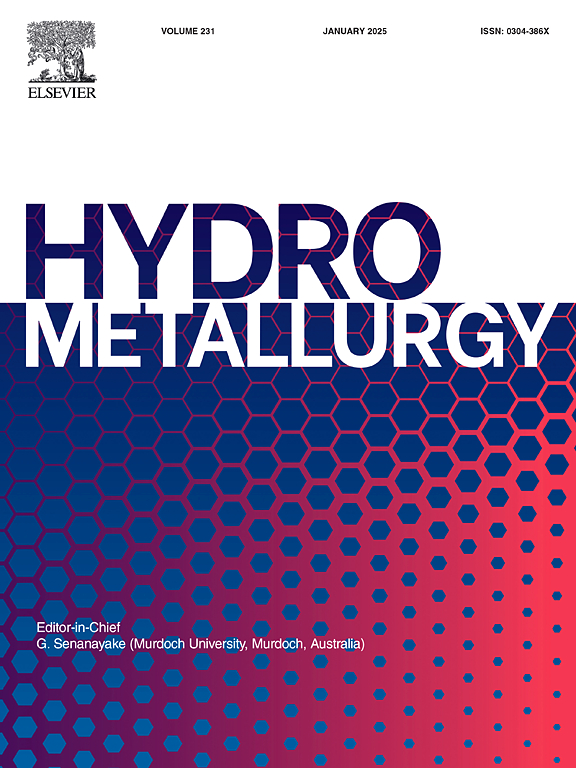Role of arsenic(V) and bismuth in the recovery of antimony by hydrolysis and precipitation from eluates produced during copper electrorefining
IF 4.8
2区 材料科学
Q1 METALLURGY & METALLURGICAL ENGINEERING
引用次数: 0
Abstract
The recovery of antimony from side stream is challenging due to impurities like arsenic and bismuth which affect extraction efficiency and product quality. This study examines the individual and combined effects of As and Bi on antimony hydrolysis from eluates produced during copper electrorefining. Synthetic and process eluates were analysed to optimise operating conditions and understand impurity interactions. Hydrolysis experiments across pH values (0.25–0.9) revealed an optimal pH range (0.6–0.7) for maximizing antimony recovery (>90 %) in impurity-free conditions. Arsenic reduced the antimony recovery by 8 %–13 %, destabilising precipitates and forming amorphous phases. Bismuth caused a smaller reduction (3 %–7 %) but had a diminished effect in the presence of As, which dominated the system's chemistry. Process eluates exhibited greater variability, particularly in extraction yields, underscoring the need to validate findings based on synthetic solutions against industrial matrices. This study provides insights into optimizing antimony recovery through impurity management and highlights the value of combining the analyses of synthetic and process eluates.
砷(V)和铋在铜电精炼过程中水解和沉淀法回收锑中的作用
从侧流中回收锑是一项具有挑战性的工作,因为砷和铋等杂质会影响提取效率和产品质量。本研究考察了As和Bi对铜电精炼过程中产生的洗脱液中锑水解的单独和联合影响。对合成和工艺洗脱液进行分析,以优化操作条件并了解杂质相互作用。不同pH值(0.25-0.9)的水解实验表明,在无杂质条件下,最大限度地提高锑回收率(> 90%)的最佳pH范围(0.6-0.7)。砷使锑的回收率降低了8% - 13%,使沉淀不稳定并形成非晶相。铋引起了较小的还原(3% - 7%),但在As存在的情况下效果减弱,As主导了系统的化学反应。工艺洗脱液表现出更大的可变性,特别是在提取产量方面,强调需要根据工业基质验证基于合成溶液的发现。该研究为通过杂质管理优化锑回收提供了见解,并突出了将合成和工艺洗脱液分析相结合的价值。
本文章由计算机程序翻译,如有差异,请以英文原文为准。
求助全文
约1分钟内获得全文
求助全文
来源期刊

Hydrometallurgy
工程技术-冶金工程
CiteScore
9.50
自引率
6.40%
发文量
144
审稿时长
3.4 months
期刊介绍:
Hydrometallurgy aims to compile studies on novel processes, process design, chemistry, modelling, control, economics and interfaces between unit operations, and to provide a forum for discussions on case histories and operational difficulties.
Topics covered include: leaching of metal values by chemical reagents or bacterial action at ambient or elevated pressures and temperatures; separation of solids from leach liquors; removal of impurities and recovery of metal values by precipitation, ion exchange, solvent extraction, gaseous reduction, cementation, electro-winning and electro-refining; pre-treatment of ores by roasting or chemical treatments such as halogenation or reduction; recycling of reagents and treatment of effluents.
 求助内容:
求助内容: 应助结果提醒方式:
应助结果提醒方式:


